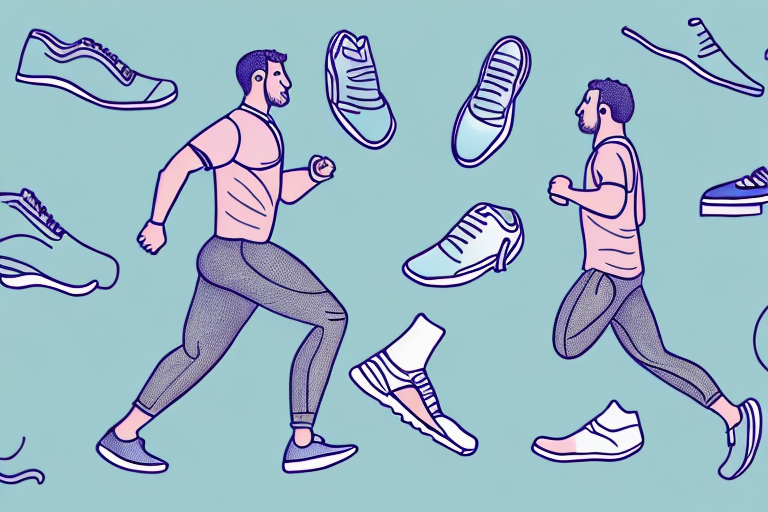Here are some benefits of running to keep in mind, along with tips on choosing the right shoes and staying safe while you’re out there.
So, you’ve decided to start running for your health.
Congratulations!
Running is a fantastic way to improve your physical fitness and boost your mental well-being.
But,
Before you lace up those shoes and hit the pavement, there are a few things you need to know.
In this article, we’ll cover everything from the health benefits of running to choosing the right shoes and staying safe while you’re on the move.
Understanding the Health Benefits of Running
Running is not just a simple exercise. It is a transformative activity that has a multitude of physical and mental health benefits.
When you lace up your running shoes and hit the pavement, you embark on a journey towards a healthier and happier you.
Physical Health Benefits
Running is a full-body workout that engages your muscles, strengthens your heart, and improves your cardiovascular endurance.
As you pound the pavement, your leg muscles work in unison, propelling you forward and increasing their strength and tone.
This not only improves your running performance but also enhances your overall physical fitness.
Moreover,
Running is an excellent way to shed those extra pounds.
By engaging in regular running sessions, you can burn a significant number of calories, leading to weight loss and improved body composition.
As the numbers on the scale decrease, you will notice an increase in your confidence and self-esteem.
In addition to weight loss, running has been shown to reduce the risk of chronic diseases.
Regular running can help lower your blood pressure, decrease your cholesterol levels, and improve your insulin sensitivity.
By incorporating running into your lifestyle, you are taking proactive steps toward preventing conditions such as heart disease, diabetes, and stroke.
Furthermore,
Running is not only beneficial for your muscles and cardiovascular system but also for your bones and joints.
Contrary to popular belief, running does not harm your joints.
Instead, it strengthens them.
The repetitive impact of running stimulates bone growth, making your bones denser and less prone to fractures.
Additionally, running helps maintain the integrity of your joints by promoting the production of synovial fluid, which acts as a lubricant and reduces friction.
As you push your limits during a run, your body releases endorphins, often called the “feel-good hormones.”
These endorphins enhance your mood, reduce stress levels.
It provides a sense of euphoria.
It’s no wonder why many people turn to running as a natural way to improve their mental well-being.
The combination of physical exertion, fresh air, and the release of endorphins creates a powerful cocktail that uplifts your spirits and boosts your overall happiness.
Mental Health Benefits
We talked about the physical benefits of running. It also has a profound impact on mental health.
Running can be a powerful tool in reducing symptoms of depression and anxiety.
The rhythmic motion of running, combined with deep breathing and increased oxygen intake, helps regulate brain chemicals, such as serotonin and dopamine.
Dopamine plays a crucial role in mood regulation.
Furthermore, running has been shown to boost self-esteem and improve cognitive function.
As you set and achieve running goals, you develop a sense of accomplishment and gain confidence in your abilities.
This newfound self-assurance can spill over into other areas of your life, empowering you to overcome challenges both on and off the track.
Whether you’re dealing with stress from work or personal life, running can be your ultimate stress-buster.
The rhythmic motion of running, combined with the peacefulness of being outdoors, can help clear your mind and promote mindfulness.
As you focus on your breath and the rhythm of your footsteps, you enter a state of flow where worries and anxieties fade away, leaving you feeling refreshed and rejuvenated.
In conclusion, running is not just a form of exercise. It is a holistic experience that benefits both your body and mind.
By incorporating running into your lifestyle, you can improve your physical fitness, reduce the risk of chronic diseases, boost your mood, and enhance your overall well-being.
So,
Lace up your running shoes, hit the pavement, and embark on a journey toward a healthier and happier you!
Preparing to Start Your Running Journey
Embarking on a running journey can be an exciting and fulfilling experience.
Whether you’re a beginner or looking to get back into running, it’s vital to lay a solid foundation for success.
We will explore some key aspects of preparing to start your running journey and provide valuable insights to help you along the way.
Setting Realistic Goals
It iss essential to set realistic goals that align with your current fitness level and schedule.
Setting goals gives you something to strive for and helps you stay focused and motivated.
Start with small milestone
Run for 10 minutes
Don’t stop or complete a 1-mile run, and gradually increase your distance to 5km or more.
It’s important to remember that everyone’s journey is unique, and progress may vary from person to person.
Don’t compare yourself to others, but instead focus on your own growth and improvement.
Celebrate each achievement, no matter how small, and use it as fuel to push yourself further.
Creating a Running Schedule
Make a routine!
By setting aside specific days and times for your runs, you treat them as non-negotiable appointments with yourself.
Consistency is key when it comes to building endurance and seeing progress.
When creating your running schedule, consider your other commitments and responsibilities.
Find windows of time that work best for you, whether it’s early morning, during lunch breaks, or in the evenings.
By finding a time that suits your lifestyle, you increase the chances of sticking to your schedule.
Starting with two to three days a week is a great way to ease into your running routine.
As you become more comfortable, gradually increase your frequency.
However,
It’s important to listen to your body and give yourself rest days to prevent overuse injuries.
Cross-training activities, such as cycling or swimming, can also be incorporated into your schedule to provide variety and give your body a break from running.
Remember,
Building endurance and improving your running abilities takes time.
Be patient with yourself and trust the process.
Consistency, determination, and a positive mindset will help you achieve your running goals.
Choosing the Right Running Shoes
Understanding Different Types of Running Shoes
What does come to your mind when you buy shoes for running? – Comfort and safety!
There are three primary types of running shoes
Stability shoes, neutral shoes, and minimalist shoes.
Stability shoes are designed to support runners with overpronation, which is when the foot rolls inward excessively.
These shoes have features such as a medial post or a firmer midsole to provide extra support and prevent the foot from moving too far inward.
They are ideal for runners who have low arches or flat feet.
Stability shoes help promote a more neutral foot strike and prevent injuries caused by overpronation.
On the other hand, neutral shoes provide a balance of cushioning and support.
They are designed for runners with a neutral foot strike, meaning the foot rolls slightly inward upon landing and then rolls slightly outward during push-off.
These shoes have a midsole that offers cushioning and flexibility without excessive stability features. Neutral shoes are suitable for runners with normal arches and a biomechanically efficient gait.
Minimalist shoes have a lightweight and flexible design, promoting a more natural running motion.
These shoes are characterized by a low heel-to-toe drop, minimal cushioning, and a thin sole.
They aim to mimic barefoot running, allowing the foot to move and flex naturally.
Minimalist shoes are best suited for experienced runners with strong foot and leg muscles, as they require a higher level of strength and stability to prevent injuries.
So, what is the right type of running shoe for you?
It is important to consider your foot type and running style.
If you’re unsure, consult with a podiatrist or a knowledgeable salesperson at a specialty running store who can assess your needs and recommend the appropriate shoe.
How to Find the Perfect Fit
Now that you know the different types of running shoes, it’s time to find the perfect fit.
Visiting a specialty running store is highly recommended, as the staff there are trained to analyze your gait and recommend the right shoe for you.
When trying on running shoes, it’s important to wear the same type of socks that you would typically wear during your runs.
This ensures a more accurate fit.
Start by trying on several pairs of shoes that match your foot type and running style.
Lace them up properly and walk around the store to get a feel for the fit and comfort.
Once you have a few pairs that feel good while walking, it’s time to take them for a test run.
Most specialty running stores have a treadmill or an area where you can try out the shoes.
Run in each pair for a few minutes, paying attention to how they feel.
Look for any discomfort, rubbing, or pressure points.
Remember,
Your feet can swell during a run, so make sure there’s about a thumb’s width of space between your longest toe and the front of the shoe.
This allows for proper toe splay and prevents your toes from hitting the front of the shoe, which can lead to painful blisters and toenail damage.
Additionally, consider the width of the shoe. Your feet should feel snug, but not overly tight.
If the shoe feels too narrow or too wide, try a different size or width option.
Lastly,
Don’t forget to check the heel fit.
Your heel should feel secure and not slip up and down as you walk or run.
If you experience any slippage, the shoe may not be the right fit for you.
By taking the time to find the perfect fit, you can ensure that your running shoes provide the necessary support, comfort, and protection for your feet, helping you to enjoy your runs and minimize the risk of injuries.
Running Techniques for Beginners
Proper Running Form
Running with proper form not only maximizes your efficiency but also reduces the risk of injury.
Keep your body relaxed, stand tall, and maintain a slight forward lean. Focus on landing midfoot and rolling through to toe-off.
Keep your arms bent at a 90-degree angle and swing them naturally in line with your stride. Avoid overstriding, as this can increase the impact on your joints.
Breathing Techniques While Running
Learning how to breathe correctly while running can improve your endurance and prevent stitch-like discomfort.
Breathe deeply from your diaphragm, inhaling through your nose and exhaling through your mouth.
Find a breathing pattern that feels comfortable for you, such as matching your breath to your steps or using a 2:2 or 3:3 ratio (inhale for two or three steps, exhale for two or three steps).
Remember to breathe rhythmically and avoid shallow breathing.
Staying Safe While Running
Running in Different Weather Conditions
Running in various weather conditions can add excitement to your routine, but it’s essential to take precautions.
In hot weather, hydrate well before and during your run, wear breathable clothing, and avoid running during the hottest part of the day.
In cold weather, dress in layers to regulate your body temperature and protect yourself from wind chill. Adjust your pace and be cautious of slippery surfaces in rainy or snowy conditions.
Safety Tips for Running at Night
If you prefer running after the sun goes down, prioritize safety while on the road.
Wear reflective clothing and accessories to make yourself visible to drivers.
Stick to well-lit areas and avoid wearing headphones that may limit your awareness of your surroundings.
It’s also a good idea to let someone know your route and approximate return time, just in case.
Now that you have a comprehensive guide to starting your running journey, it’s time to take the first step.
Remember to ease into your new routine, set realistic goals, invest in proper running shoes, and prioritize safety.
Running may seem challenging at first, but with perseverance and consistency, you’ll find yourself enjoying all the physical and mental benefits it has to offer.
------ Happy Running -----




